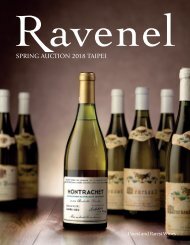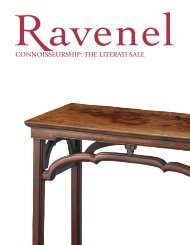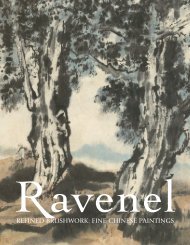亞洲現代與當代藝術 Modern and Contemporary Asian Art
羅芙奧2018春季拍賣會 亞洲現代與當代藝術 Ravenel Spring Auction 2018 Modern and Contemporary Asian Art
羅芙奧2018春季拍賣會 亞洲現代與當代藝術 Ravenel Spring Auction 2018 Modern and Contemporary Asian Art
Create successful ePaper yourself
Turn your PDF publications into a flip-book with our unique Google optimized e-Paper software.
BEYOND THE FINITE<br />
This piece, known as Sans titre, was created by Chu Teh-chun in<br />
1983. Witnessing the masterly brush’s color configuration is like<br />
listening to the melody of a great piece of music. The rhythm <strong>and</strong><br />
cadence are intricately interwoven like a dance. The thickness of<br />
the contours are staggered, layered <strong>and</strong> juxtaposed in the picture,<br />
forming a harmonious <strong>and</strong> ambient atmosphere. The picture with<br />
the warm colors is like an impassioned <strong>and</strong> gentle symphony.<br />
Moreover, the spirit of the Chinese style brush strokes is seen in<br />
both the large <strong>and</strong> small dots. Through this, the art manifests a<br />
bright <strong>and</strong> ephemeral poetic spirit. Wu Guang-zhong, the peer in<br />
Hangzhou School of Fine <strong>Art</strong>s, also commented that each one of<br />
Chu’s paintings are like kinetic harmonies, the beauty of rhythm is<br />
unified in harmonic colors, it’s like “To watch others dance before<br />
a crystal, looks intense but also totally silent, as if unconstrained<br />
strengths were all melted in one placid beauty.”<br />
THE MAGNIFICENT GLORY OF THE GOLDEN ERA<br />
This overview of Chu Teh-chun’s artwork is akin to appreciating<br />
a lyrical epic. The methods of textural painting often gives the<br />
viewers a feeling of spiritual energy. The most appropriate phrase<br />
for describing his artworks is “vivid artistic conception”. He was<br />
constantly transforming <strong>and</strong> refining his methods <strong>and</strong> was full<br />
of an almost supernatural enthusiasm. Regarding the various<br />
interpretations of his art as well as his artistic reproduction of<br />
nature, it has been pointed out that some of his transformations<br />
went beyond an objective rendition of the l<strong>and</strong>scape but rather<br />
had become a highly subjective <strong>and</strong> poetic expression instead.<br />
Via the transition from the specific to the abstract, he has created<br />
a portrayal of the intellectual realizations he had accumulated<br />
throughout his life.<br />
Born in a time of turmoil <strong>and</strong> cultural flows, Chu Teh-chun had<br />
transitioned from a traditional Chinese environment to a modern<br />
European aesthetic. Beginning in the 1980s, Chu Teh-chun began<br />
employing oriental charm as a basis for complementing features of<br />
Western artistic expression. The brushstrokes <strong>and</strong> contours of his<br />
art are reminiscent of the forms found in Chinese calligraphy. Xie<br />
Hun, an art historian from the Southern Qi Dynasty, describes in his<br />
seminal work, “The Record of the Classification of Old Painters”,<br />
the Six principles of Chinese painting: spirit resonance, bone<br />
method, correspondence to the object, suitability to type, division<br />
<strong>and</strong> planning <strong>and</strong> transmission by copying. One can easily see that<br />
the first two principles, spirit resonance <strong>and</strong> the bone method, are<br />
incorporated in Chu Teh-chun’s artworks.<br />
()1365<br />
Yuan Dynasty, Wang Meng, A Solitaire Living in Xianshan Peak, c.1365, color on silk,<br />
149x63.5cm, Collection of Palace Museum, Beijing, China<br />
In addition to embodying the representation of oriental culture,<br />
Chu Teh-chun had also liberated his artistic forms from the confines<br />
of specific matters, manifesting in a penetration of magnificent<br />
gr<strong>and</strong>eur. Beyond just representing the unique symbolism <strong>and</strong><br />
characteristics of music among the Chinese literati, Chu Teh-chun’s<br />
art had another manifestation as well: a unique esoteric motif that<br />
is repeatedly reflected in his works, namely a meditation on the<br />
vastness <strong>and</strong> boundlessness of the universe. Through this detached<br />
sentimental style, he conveys his esteem for the beauty of nature.<br />
The overall picture was particularly effective at capturing <strong>and</strong><br />
conveying the feeling <strong>and</strong> texture of air. In Chu Teh-chun’s paintings,<br />
he had rearranged the scenery that he witnesses. Whether it is the<br />
lighting of a portrait or the oriental heritage which permeates the<br />
atmosphere, he had broken the principles of conventional judgment<br />
one step at a time. His one-of-a-kind artistic forms are an ingenious<br />
fusion of Eastern <strong>and</strong><br />
Western influences.<br />
He uses an abstract<br />
naturalistic approach<br />
to allow these unique<br />
cultural sources to<br />
blend with each<br />
other, preserving their<br />
positive attributes<br />
while discarding their<br />
superfluous elements.<br />
It is as so though<br />
the horizon were a<br />
surging, radiating<br />
<strong>and</strong> magnificent<br />
flower that bloomed<br />
with unprecedented<br />
vitality.







